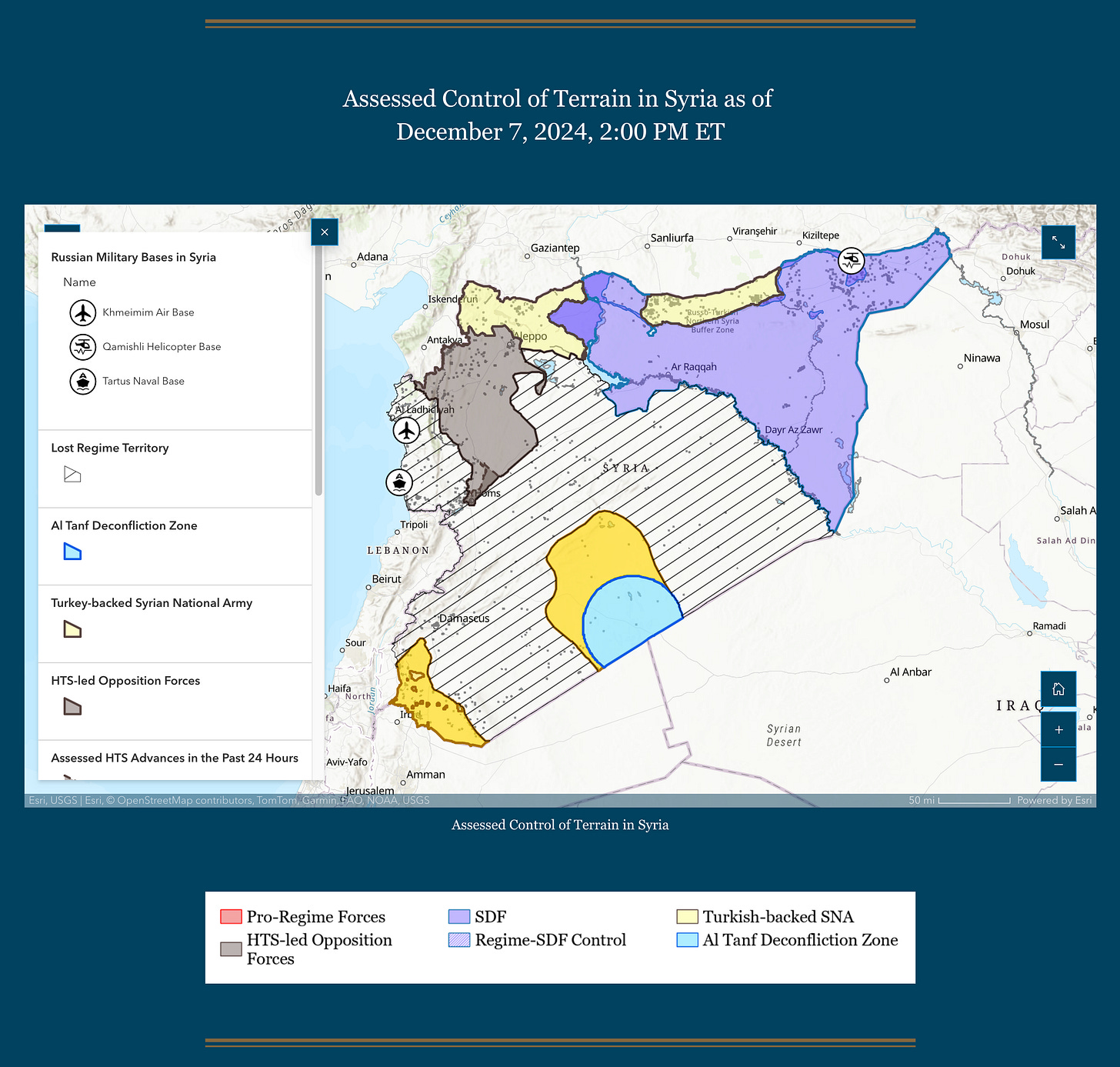Breaking the 'Axis of Resistance': A Strategic Guide to Syria’s Collapse
A Comprehensive Collection of Key Reports and Analyses to Help You Understand How Syria’s Collapse and the Fall of Assad Impact U.S. and Israeli Interests and Shape the Region’s Future
Syria After Assad: What’s Next for Israel?
The collapse of Bashar al-Assad’s regime marks a significant shift in the Middle East’s geopolitical landscape. After 54 years of Assad family rule, Syria now faces a period of uncertainty, with potential scenarios ranging from territorial fragmentation to the emergence of a unified or federal political structure. Each outcome presents distinct challenges and opportunities for Israel’s national security and regional policy.
In addition, the fall of Assad represents a serious blow to Iran’s Axis of Resistance, disrupting its influence in Syria and raising questions about Hezbollah’s ability to sustain its operational capacities. However, the vacuum left by Assad could also lead to increased instability along Israel’s northern border and the rise of extremist factions.
Key Strategic Considerations
Iran’s Setback: The collapse of Assad’s regime weakens Tehran’s ability to project power in Syria, undermining the Axis of Resistance’s cohesion (“The Fall of the Assad Regime—A Dramatic Blow to Iran’s Axis of Resistance”, Dec. 8, 2024, INSS).
Regional Instability: A fractured Syria may create ungoverned spaces near Israel’s northern border, increasing the likelihood of extremist activity (“The Fall of Assad’s Regime: Between Risks and Opportunities”, Dec. 8, 2024, INSS).
Opportunities for Israel: With Iranian influence diminished, Israel can strengthen its strategic position through regional engagement and enhanced northern border security (“The Fall of Assad’s Regime: Between Risks and Opportunities”, Dec. 8, 2024, INSS).
Iran’s Axis of Resistance in Crisis
For decades, Iran has relied on Syria as a critical linchpin in its Axis of Resistance, using the country as a gateway for supporting Hezbollah and projecting power against Israel and U.S. interests in the region. With Assad’s fall, Tehran faces one of its most significant geopolitical challenges in recent memory, offering a strategic opportunity for both Israel and the United States to capitalize on Iran’s weakened position.
Key Impacts on Iran
Collapse of Strategic Depth: Assad’s regime was a critical element of Iran’s regional influence, providing a land corridor to Hezbollah in Lebanon. Its fall disrupts the network Qasem Soleimani built to protect Iran’s interests and expand its reach (“Khamenei Loses Everything”, Dec. 2024, The Atlantic).
Weakening of Hezbollah: Without Assad, Hezbollah loses logistical and strategic support, complicating its ability to rebuild capabilities damaged by Israeli strikes (“Khamenei Loses Everything”, Dec. 2024, The Atlantic).
Iran’s Nuclear Dilemma: Facing diminished regional influence, Iran may recalibrate its nuclear strategy, potentially pursuing higher enrichment levels to bolster deterrence. However, such moves are fraught with risk, especially given Israel’s demonstrated capacity for preemptive action and the return of a U.S. administration hostile to Iranian ambitions (“Khamenei Loses Everything”, Dec. 2024, The Atlantic).
For Israel, this is an opportunity to diminish a long-standing adversary's influence, while for the United States, it reaffirms the importance of a robust, proactive presence in the region.
Background: Syria and U.S. Foreign Policy Since 2011
Since the outbreak of conflict in 2011, U.S. foreign policy toward Syria has focused on countering terrorism, mitigating humanitarian crises, and managing the influence of external actors such as Russia, Iran, and Turkey. The ongoing instability following the fall of Bashar al-Assad’s regime adds a new layer of complexity to U.S. objectives in the region.
Key U.S. Policy Objectives
Countering ISIS and Terrorism
U.S. forces maintain approximately 800 personnel in Syria under Operation Inherent Resolve (OIR), focusing on the enduring defeat of ISIS. These troops support the Syrian Democratic Forces (SDF) in counter-ISIS operations, particularly in detaining ISIS fighters and preventing the group’s resurgence (CRS, IF11930, July 2024).
Addressing Regional Threats
Iran: Iran-backed militias and their use of Syria for operations against U.S. and allied forces remain a critical concern. The U.S. has conducted strikes targeting Iranian-linked facilities to protect its personnel and interests (CRS, IF11930, July 2024).
Turkey: Turkey’s military operations in Kurdish-controlled regions of Syria complicate U.S. partnerships with the SDF, which Turkey views as linked to the Kurdistan Workers’ Party (PKK), a designated terrorist organization (CRS, IF11080, Aug. 2023).
Humanitarian Assistance and Stabilization
The United States is the largest donor to humanitarian efforts in Syria, contributing $17.8 billion since 2012 to address the needs of over 16.7 million Syrians requiring assistance. Cross-border aid remains essential for reaching opposition-controlled areas (CRS, IF11930, July 2024).
Further Reading: Comprehensive Analysis and Reports
DOD Report: Operation Inherent Resolve (July 2024)
This report provides a detailed overview of the ongoing U.S. military operations under OIR, highlighting key priorities, partner force engagements, and the evolving role of U.S. troops in Iraq and Syria.
Department of Defense (DOD), October 2024.
Access Full ReportCRS Report: U.S. Policy in Syria (July 2024)
An in-depth look at the U.S. strategy in Syria, covering counter-ISIS campaigns, humanitarian challenges, and policy implications for regional stability.
Congressional Research Service (CRS), July 2024.
Access Full ReportThe Fall of Syria’s Assad Regime: Strategic Implications for the Axis of Resistance
An analysis of the impact of Assad’s fall on Iran’s Axis of Resistance and its long-term implications for U.S. and Israeli interests.
The Atlantic, December 2024.
Access ArticleIraq and U.S. Security Partnership Transition Plan (September 2024)
This Defense Department document outlines the phased transition plan for U.S. military operations in Iraq, focusing on building sustainable Iraqi security capacities.
U.S. Department of Defense, September 2024.
Access DocumentSyria’s Humanitarian Crisis: U.S. Aid Contributions and Challenges
A comprehensive review of U.S. humanitarian aid efforts in Syria, emphasizing cross-border operations and strategies for addressing long-term needs.
USAID, October 2024.
Access Briefing







